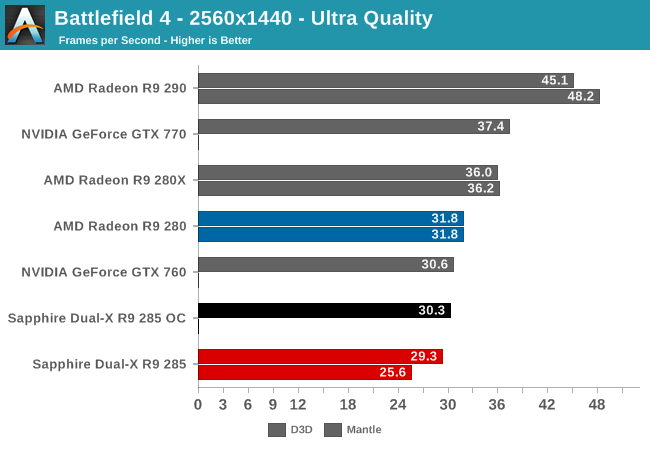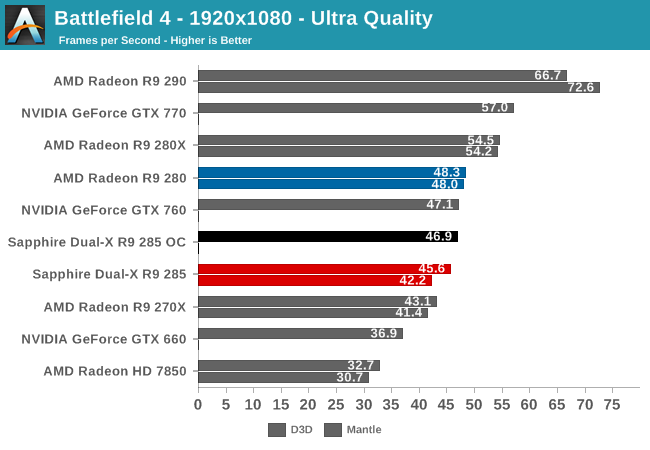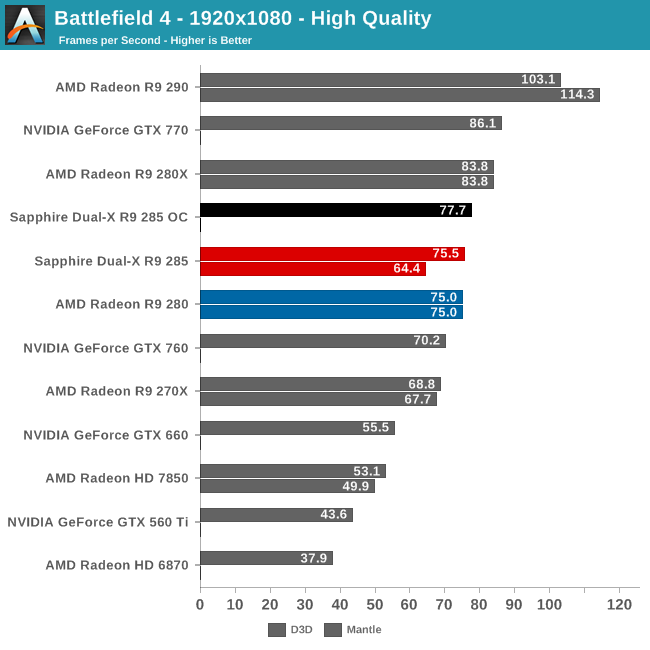AMD Radeon R9 285 Review: Feat. Sapphire R9 285 Dual-X OC
by Ryan Smith on September 10, 2014 2:00 PM ESTBattlefield 4
Our latest addition to our benchmark suite and our current major multiplayer action game of our benchmark suite is Battlefield 4, DICE’s 2013 multiplayer military shooter. After a rocky start, Battlefield 4 has finally reached a point where it’s stable enough for benchmark use, giving us the ability to profile one of the most popular and strenuous shooters out there. As these benchmarks are from single player mode, based on our experiences our rule of thumb here is that multiplayer framerates will dip to half our single player framerates, which means a card needs to be able to average at least 60fps if it’s to be able to hold up in multiplayer.



Our first Mantle-enabled game, Battlefield 4 shows the current Mantle R9 285 performance regressions front and center. At every resolution the R9 285 loses performance, sometimes remarkably so. As a result it is limited to Direct3D.
Regressions aside, I feel like Battlefield 4 is a good case for why the R9 285 needs more VRAM, or at the very least it’s not a good choice for 2560x1440. The sustained performance at 2560 is too low for this game, and the performance loss compared to the 3GB R9 280 appears to be a direct result of VRAM pressure. If the R9 285 had more VRAM, I suspect it would reach parity with the R9 280, especially given what happens at 1080p with High settings.
In any case, this is also the first game where the R9 285 trades blows with the GTX 760 rather than taking a distinct lead. With both cards limited to Direct3D, both cards are also returning similar performance. Which for R9 285 and its higher price tag is essentially a loss.










86 Comments
View All Comments
Alexvrb - Tuesday, September 16, 2014 - link
"if other GCN 1.1 parts like Hawaii are any indication, it's much more likely the 280 maintains its boost clocks compared to the 285 (due to low TDP limits)"This is what you said. This is where I disagreed with you. The 285 maintains boost just as well as the 280. Further, GCN 1.1 Bonaire and even Hawaii reach and hold boost at stock TDP. The 290 series were not cooled sufficiently using reference coolers, but without any changes to TDP settings (I repeat, stock TDP) they boost fine as long as you cool them. GCN 1.1 boosts fine, end of story.
As far as Tonga goes, there's almost no progress in performance terms. In terms of power it depends on the OEM and I've seen good and bad. The only additions that really are interesting are the increased tessellation performance (though not terribly important at the moment) and finally getting TrueAudio into a mid-range part (it should be across the board by next gen I would hope - PS4 and XB1 have the same Tensilica DSPs).
I would hope they do substantially better with their future releases, or at least release a competent reference design that shows off power efficiency better than some of these third party designs.
chizow - Wednesday, September 17, 2014 - link
Yes, and my comment was correct, it will ALWAYS be "more likely" the 280 maintains its boost over other GCN 1.x parts because we know the track record of GCN 1.0 cards and their conservative Boost compared to post-PowerTune GCN1.x and later parts as a result of the black eye caused by Hawaii. There will always be a doubt due to AMD's less-than-honest approach to Boost with Hawaii, plain and simple.I also (correctly) qualified my statement by saying the low stated TDP of the 285 would be a hindrance to exceeding those rated specs and/or the performance of the 280, and we also see that is the case that in order to exceed those speed limits, AMD traded performance for efficiency to the point the 285's power consumption is actually closer to the 250W rated 280.
In any case, in another day or two, this unremarkable part is going to become irrelevant with GM104 Maxwell, no need to further waste any thoughts on it.
etherlore - Thursday, September 11, 2014 - link
Speculating here. The data parallel instructions could be a way to share data between SIMD lanes. I could see this functionality being similar in functionality to what threadgroup local store allows, but without explicit usage of the local store.It's possible this is an extension to, or makes new use of, the 32 LDS integer units in GCN. (section 2.3.2 in the souther islands instruction set docs)
vred - Thursday, September 11, 2014 - link
And... DP rate at last. Sucks to have it at 1/16 but at least now it's confirmed. First review where I see this data published.chizow - Thursday, September 11, 2014 - link
It has to be artificially imposed, as AMD has already announced FirePro cards based on the Tonga ASIC that do not suffer from this castrated DP rate. AMD as usual taking a page from Nvidia's playbook, so now all the AMD fans poo-poo'ing Nvidia's sound business decisions can give AMD equal treatment. Somehow I doubt that will happen though!Samus - Thursday, September 11, 2014 - link
If this is AMD's Radeon refresh, if the 750Ti tells us anything, they are screwed when Maxwell hits the streets next month.Atari2600 - Thursday, September 11, 2014 - link
The one thing missed in all this - APUs.As we all know, APUs are bandwidth starved. A 30-40% increase in memory subsystem efficiency will do very nicely for removing a major bottleneck.
That is before the move to stacked chips or eDRAM.
limitedaccess - Thursday, September 11, 2014 - link
@RyanRegarding the compression (delta color compression) changes for Tonga does this have any effect on the actual size of data stored in VRAM.
For instance if you take a 2gb Pitcarin card and a 2gb Tonga card showing the identical scene in a game will they both have identical (monitored) VRAM usage? Assuming of course the scenario here is neither is actually hitting the 2gb VRAM limit.
I'm wondering if it possible to test whether or not this is the case if unconfirmed.
Ryan Smith - Sunday, September 14, 2014 - link
VRAM usage will differ. Anything color compressed will take up less space (at whatever ratio the color compression algorithm allows). Of course this doesn't account for caching and programs generally taking up as much VRAM as they can, so it doesn't necessarily follow that overall VRAM usage will be lower on Tonga than Pitcairn. But it is something that can at least be tested.abundantcores - Thursday, September 11, 2014 - link
I see Anand still don't understand the purpose of Mantle, if they did they wouldn't be using the most powerful CPU they could find, i would explain it to them but i think its already been explained to them a thousand times and they still don't grasp it.Anand are a joke, they have no understanding of anything.